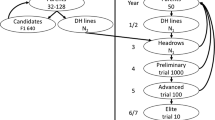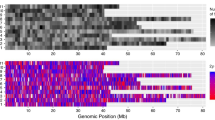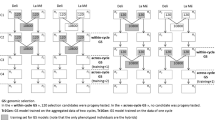Abstract
Key message
Simulations highlight the potential of genomic selection to substantially increase genetic gain for complex traits in sugarcane. The success rate depends on the trait genetic architecture and the implementation strategy.
Abstract
Genomic selection (GS) has the potential to increase the rate of genetic gain in sugarcane beyond the levels achieved by conventional phenotypic selection (PS). To assess different implementation strategies, we simulated two different GS-based breeding strategies and compared genetic gain and genetic variance over five breeding cycles to standard PS. GS scheme 1 followed similar routines like conventional PS but included three rapid recurrent genomic selection (RRGS) steps. GS scheme 2 also included three RRGS steps but did not include a progeny assessment stage and therefore differed more fundamentally from PS. Under an additive trait model, both simulated GS schemes achieved annual genetic gains of 2.6–2.7% which were 1.9 times higher compared to standard phenotypic selection (1.4%). For a complex non-additive trait model, the expected annual rates of genetic gain were lower for all breeding schemes; however, the rates for the GS schemes (1.5–1.6%) were still greater than PS (1.1%). Investigating cost–benefit ratios with regard to numbers of genotyped clones showed that substantial benefits could be achieved when only 1500 clones were genotyped per 10-year breeding cycle for the additive genetic model. Our results show that under a complex non-additive genetic model, the success rate of GS depends on the implementation strategy, the number of genotyped clones and the stage of the breeding program, likely reflecting how changes in QTL allele frequencies change additive genetic variance and therefore the efficiency of selection. These results are encouraging and motivate further work to facilitate the adoption of GS in sugarcane breeding.










Similar content being viewed by others
References
Aitken KS, Jackson PA, McIntyre CL (2005) A combination of AFLP and SSR markers provides extensive map coverage and identification of homo(eo)logous linkage groups in a sugarcane cultivar. Theor Appl Genet 110(5):789–801. https://doi.org/10.1007/s00122-004-1813-7
Aitken KS, McNeil MD, Hermann S, Bundock PC, Kilian A, Heller-Uszynska K, Henry RJ, Li J (2014) A comprehensive genetic map of sugarcane that provides enhanced map coverage and integrates high-throughput Diversity Array Technology (DArT) markers. BMC Genomics 15:152. https://doi.org/10.1186/1471-2164-15-152
Aitken K, Farmer A, Berkman P, Muller C, Wei X, Demano E, Jackson P, Magwire M, Dietrich B, Kota R (2016) Generation of a 345K sugarcane SNP chip. Proc Int Soc Cane Technol 29:1923–1930
Baker P, Jackson P, Aitken K (2010) Bayesian estimation of marker dosage in sugarcane and other autopolyploids. TAG. Theoretical and applied genetics. Theoretische und angewandte Genetik 120(8):1653–1672. https://doi.org/10.1007/S00122-010-1283-Z
Bernardo R (2020) Reinventing quantitative genetics for plant breeding: something old, something new, something borrowed, something BLUE. Heredity. https://doi.org/10.1038/s41437-020-0312-1
Bernardo R, Yu J (2007) Prospects for Genomewide Selection for Quantitative Traits in Maize. Crop Sci 47(3):1082. https://doi.org/10.2135/cropsci2006.11.0690
Bhuiyan SA, Croft BJ, Cox MC (2013) Breeding for sugarcane smut resistance in Australia and industry response: 2006–2011. Proceedings of the Australian Society of Sugar Cane Technologists 1–9
Cheverud JM, Routman EJ (1995) Epistasis and its contribution to genetic variance components. Genetics 139(3):1455–1461
Cheverud JM, Routman EJ (1996) Epistasis as a source of increased additive genetic variance at population bottlenecks. Evol Int J Org Evol 50(3):1042–1051. https://doi.org/10.1111/j.1558-5646.1996.tb02345.x
Comstock RE, Robinson HF, Harvey PH (1949) A breeding procedure designed to make maximum use of both general and specific combining ability 1. Agron J 41(8):360–367. https://doi.org/10.2134/agronj1949.00021962004100080006x
Cooper M, Podlich DW, Micallef KP, Smith OS, Jensen NM, Chapman SC, Kruger NL (2002) Complexity, quantitative traits and plant breeding: a role for simulation modelling in the genetic improvement of crops. In: Kang MS (ed) Quantitative genetics, genomics, and plant breeding. CABI Pub, Oxon, UK, New York, pp 143–166
Cooper M, Gho C, Leafgren R, Tang T, Messina C (2014) Breeding drought-tolerant maize hybrids for the US corn-belt. Discovery to product. J Exp Bot 65(21):6191–6204. https://doi.org/10.1093/jxb/eru064
Cros D, Denis M, Bouvet J-M, Sánchez L (2015) Long-term genomic selection for heterosis without dominance in multiplicative traits: case study of bunch production in oil palm. BMC Genomics 16:651. https://doi.org/10.1186/s12864-015-1866-9
de Bem Oliveira I, Resende MFR, Ferrão LFV, Amadeu RR, Endelman JB, Kirst M, Coelho ASG, Munoz PR (2019) Genomic prediction of autotetraploids; Influence of relationship matrices, allele dosage, and continuous genotyping calls in phenotype prediction. G3 Bethesda, Md 9(4):1189–1198. https://doi.org/10.1534/g3.119.400059
de Lara CLA, Santos MF, Jank L, Chiari L, Vilela MDM, Amadeu RR, Dos Santos JPR, Pereira GdS, Zeng Z-B, Garcia AAF (2019) Genomic selection with allele dosage in panicum maximum Jacq. G3 Bethesda, Md 9(8):2463–2475. https://doi.org/10.1534/g3.118.200986
de Morais LK, de Aguiar MS, Albuquerque e Silva P de, Câmara TMM, Cursi DE, Júnior ARF, Chapola RG, Carneiro MS, Bespalhok Filho JC (2015) Breeding of sugarcane. In: Cruz VMV, Dierig DA (eds) Industrial crops, vol 9. Springer, New York, NY, pp 29–42
de Oliveira EJ, de Resende MDV, da Silva SV, Ferreira CF, Oliveira GAF, da Silva MS, de Oliveira LA, Aguilar-Vildoso CI (2012) Genome-wide selection in cassava. Euphytica 187(2):263–276. https://doi.org/10.1007/s10681-012-0722-0
Deomano E, Jackson P, Wei X, Aitken K, Kota R, Pérez-Rodríguez P (2020) Genomic prediction of sugar content and cane yield in sugar cane clones in different stages of selection in a breeding program, with and without pedigree information. Mol Breed 40(4):445. https://doi.org/10.1007/s11032-020-01120-0
Endelman JB, Carley CAS, Bethke PC, Coombs JJ, Clough ME, da Silva WL, de Jong WS, Douches DS, Frederick CM, Haynes KG, Holm DG, Miller JC, Muñoz PR, Navarro FM, Novy RG, Palta JP, Porter GA, Rak KT, Sathuvalli VR, Thompson AL, Yencho GC (2018) Genetic variance partitioning and genome-wide prediction with allele dosage information in autotetraploid potato. Genetics 209(1):77–87. https://doi.org/10.1534/genetics.118.300685
Fernandes SB, Dias KOG, Ferreira DF, Brown PJ (2018) Efficiency of multi-trait, indirect, and trait-assisted genomic selection for improvement of biomass sorghum. Theor Appl Genet 131(3):747–755. https://doi.org/10.1007/s00122-017-3033-y
Gaffney J, Schussler J, Löffler C, Cai W, Paszkiewicz S, Messina C, Groeteke J, Keaschall J, Cooper M (2015) Industry-scale evaluation of maize hybrids selected for increased yield in drought-stress conditions of the US corn belt. Crop Sci 55(4):1608. https://doi.org/10.2135/cropsci2014.09.0654
Garcia AAF, Mollinari M, Marconi TG, Serang OR, Silva RR, Vieira MLC, Vicentini R, Costa EA, Mancini MC, Garcia MOS, Pastina MM, Gazaffi R, Martins ERF, Dahmer N, Sforça DA, Silva CBC, Bundock P, Henry RJ, Souza GM, van Sluys M-A, Landell MGA, Carneiro MS, Vincentz MAG, Pinto LR, Vencovsky R, Souza AP (2013) SNP genotyping allows an in-depth characterisation of the genome of sugarcane and other complex autopolyploids. Sci Rep 3:3399. https://doi.org/10.1038/srep03399
García-Ruiz A, Cole JB, VanRaden PM, Wiggans GR, Ruiz-López FJ, van Tassell CP (2016) Changes in genetic selection differentials and generation intervals in US Holstein dairy cattle as a result of genomic selection. Proc Natl Acad Sci USA 113(28):E3995-4004. https://doi.org/10.1073/pnas.1519061113
Garsmeur O, Charron C, Bocs S, Jouffe V, Samain S, Couloux A, Droc G, Zini C, Glaszmann J-C, van Sluys M-A, D’hont A, (2011) High homologous gene conservation despite extreme autopolyploid redundancy in sugarcane. New Phytol 189(2):629–642. https://doi.org/10.1111/j.1469-8137.2010.03497.x
Garsmeur O, Droc G, Antonise R, Grimwood J, Potier B, Aitken K, Jenkins J, Martin G, Charron C, Hervouet C, Costet L, Yahiaoui N, Healey A, Sims D, Cherukuri Y, Sreedasyam A, Kilian A, Chan A, van Sluys M-A, Swaminathan K, Town C, Bergès H, Simmons B, Glaszmann JC, van der Vossen E, Henry R, Schmutz J, D’hont A, (2018) A mosaic monoploid reference sequence for the highly complex genome of sugarcane. Nat Commun 9(1):2638. https://doi.org/10.1038/s41467-018-05051-5
George AW, Aitken K (2010) A new approach for copy number estimation in polyploids. J Heredit 101(4):521–524. https://doi.org/10.1093/jhered/esq034
Gorjanc G, Gaynor RC, Hickey JM (2018) Optimal cross selection for long-term genetic gain in two-part programs with rapid recurrent genomic selection. Theor Appl Genet. https://doi.org/10.1007/s00122-018-3125-3
Gouy M, Rousselle Y, Bastianelli D, Lecomte P, Bonnal L, Roques D, Efile J-C, Rocher S, Daugrois J, Toubi L, Nabeneza S, Hervouet C, Telismart H, Denis M, Thong-Chane A, Glaszmann JC, Hoarau J-Y, Nibouche S, Costet L (2013) Experimental assessment of the accuracy of genomic selection in sugarcane. Theor Appl Genet 126(10):2575–2586. https://doi.org/10.1007/s00122-013-2156-z
Haldane JBS (1919) The combination of linkage values and the calculation of distances between the loci of linked factors. Genetics 8:299–309
Hayes BJ, Wei X, Joyce P, Domano E, Yue J, Nguyen L, Ross E, Cavellero T, Aitken KS, Voss-Fels KP (2021) Accuracy of genomic prediction of complex traits in sugarcane. (companion paper, submitted)
Heffner EL, Jannink J-L, Sorrells ME (2011) Genomic selection accuracy using multifamily prediction models in a wheat breeding program. Plant Genome 4(1):65. https://doi.org/10.3835/plantgenome2010.12.0029
Hickey JM, Chiurugwi T, Mackay I, Powell W (2017) Genomic prediction unifies animal and plant breeding programs to form platforms for biological discovery. Nat Genet 49(9):1297–1303. https://doi.org/10.1038/ng.3920
Hunt CH, van Eeuwijk FA, Mace ES, Hayes BJ, Jordan DR (2018) Development of genomic prediction in sorghum. Crop Sci 58(2):690. https://doi.org/10.2135/cropsci2017.08.0469
Jannink J-L, Lorenz AJ, Iwata H (2010) Genomic selection in plant breeding. From theory to practice. Brief Funct Genomics 9(2):166–177. https://doi.org/10.1093/bfgp/elq001
Jannoo N, Grivet L, David J, D’Hont A, Glaszmann J-C (2004) Differential chromosome pairing affinities at meiosis in polyploid sugarcane revealed by molecular markers. Heredity 93(5):460–467. https://doi.org/10.1038/sj.hdy.6800524
Karlin S, Liberman U (1978) Classifications and comparisons of multilocus recombination distributions. Proc Natl Acad Sci USA 75(12):6332–6336. https://doi.org/10.1073/pnas.75.12.6332
Lorenz AJ, Smith KP, Jannink J-L (2012) Potential and optimization of genomic selection for fusarium head blight resistance in six-row barley. Crop Sci 52(4):1609. https://doi.org/10.2135/cropsci2011.09.0503
Ly D, Hamblin M, Rabbi I, Melaku G, Bakare M, Gauch HG, Okechukwu R, Dixon AGO, Kulakow P, Jannink J-L (2013) Relatedness and genotype × environment interaction affect prediction accuracies in genomic selection. Stud Cassava Crop Sci 53(4):1312. https://doi.org/10.2135/cropsci2012.11.0653
Meuwissen TH, Hayes BJ, Goddard ME (2001) Prediction of total genetic value using genome-wide dense marker maps. Genetics 157(4):1819–1829
Ming R, Liu SC, Moore PH, Irvine JE, Paterson AH (2001) QTL analysis in a complex autopolyploid: genetic control of sugar content in sugarcane. Genome Res 11(12):2075–2084. https://doi.org/10.1101/gr.198801
Ming R, Moore PH, Wu K-K, D'hont A, Glaszmann JC, Tew TL, Mirkov TE, da Silva J, Jifon J, Rai M, Schnell RJ, Brumbley SM, Lakshmanan P, Comstock JC, Paterson AH (2005) Sugarcane improvement through breeding and biotechnology. In: Janick J (ed) Plant breeding reviews, vol 30. Wiley, Oxford, pp 15–118
Osborn TC, Chris Pires J, Birchler JA, Auger DL, Jeffery Chen Z, Lee H-S, Comai L, Madlung A, Doerge RW, Colot V, Martienssen RA (2003) Understanding mechanisms of novel gene expression in polyploids. Trends Genet 19(3):141–147. https://doi.org/10.1016/s0168-9525(03)00015-5
Park S, Jackson P, Berding N, Inman-Bamber G (2007) Conventional breeding practices within the Australian sugarcane breeding program. In: Proceedings of the International Society of Cane Technologists
Piperidis N, D’hont A (2020) Sugarcane genome architecture decrypted with chromosome-specific oligo probes. Plant J Cell Mol Biol. https://doi.org/10.1111/tpj.14881
Podlich DW, Cooper M (1998) QU-GENE: a simulation platform for quantitative analysis of genetic models. Bioinform Oxford Engl 14(7):632–653
Poland J, Endelman J, Dawson J, Rutkoski J, Wu S, Manes Y, Dreisigacker S, Crossa J, Sánchez-Villeda H, Sorrells M, Jannink J-L (2012) Genomic selection in wheat breeding using genotyping-by-sequencing. Plant Genome 5(3):103. https://doi.org/10.3835/plantgenome2012.06.0006
Price S (1963) Cytogenetics of modern sugar canes. Econ Bot 17(2):97–106. https://doi.org/10.1007/BF02985359
R Core Team (2018) R: a language and environment for statistical computing. R Foundation for Statistical Computing, Vienna, Austria
Riedelsheimer C, Czedik-Eysenberg A, Grieder C, Lisec J, Technow F, Sulpice R, Altmann T, Stitt M, Willmitzer L, Melchinger AE (2012) Genomic and metabolic prediction of complex heterotic traits in hybrid maize. Nat Genet 44(2):217–220. https://doi.org/10.1038/ng.1033
Rutkoski J, Benson J, Jia Y, Brown-Guedira G, Jannink J-L, Sorrells M (2012) Evaluation of genomic prediction methods for fusarium head blight resistance in wheat. Plant Genome 5(2):51. https://doi.org/10.3835/plantgenome2012.02.0001
Slater AT, Cogan NOI, Forster JW, Hayes BJ, Daetwyler HD (2016) Improving genetic gain with genomic selection in autotetraploid potato. Plant Genome. https://doi.org/10.3835/plantgenome2016.02.0021
Spindel J, Begum H, Akdemir D, Virk P, Collard B, Redoña E, Atlin G, Jannink J-L, McCouch SR (2015) Genomic selection and association mapping in rice (Oryza sativa). Effect of trait genetic architecture, training population composition, marker number and statistical model on accuracy of rice genomic selection in elite, tropical rice breeding lines. PLoS Genet 11(2):e1004982. https://doi.org/10.1371/journal.pgen.1004982
Sugar Research Australia (2016) Annual Report 2015/16, https://sugarresearch.com.au/wp-content/uploads/2017/03/250694_SRA_Annual_Report_2015_2016.pdf, Indooroopilly QLD, Australia
Wei X, Jackson P (2016) Addressing slow rates of long-term genetic gain in sugarcane. Proc Int Soc Cane Technol 29:1923–1930
Werner CR, Qian L, Voss-Fels KP, Abbadi A, Leckband G, Frisch M, Snowdon RJ (2018) Genome-wide regression models considering general and specific combining ability predict hybrid performance in oilseed rape with similar accuracy regardless of trait architecture. Theor Appl Genet 131(2):299–317. https://doi.org/10.1007/s00122-017-3002-5
Wisser RJ, Fang Z, Holland JB, Teixeira JEC, Dougherty J, Weldekidan T, de Leon N, Flint-Garcia S, Lauter N, Murray SC, Xu W, Hallauer A (2019) The genomic basis for short-term evolution of environmental adaptation in maize. Genetics 213(4):1479–1494. https://doi.org/10.1534/genetics.119.302780
Wu KK, Burnquist W, Sorrells ME, Tew TL, Moore PH, Tanksley SD (1992) The detection and estimation of linkage in polyploids using single-dose restriction fragments. Theor Appl Genet 83(3):294–300. https://doi.org/10.1007/BF00224274
Yadav S, Jackson P, Wei X, Ross EM, Aitken K, Deomano E, Atkin F, Hayes BJ, Voss-Fels KP (2020) Accelerating genetic gain in sugarcane breeding using genomic selection. Agronomy 10(4):585. https://doi.org/10.3390/agronomy10040585
Zhang J, Zhang X, Tang H, Zhang Q, Hua X, Ma X, Zhu F, Jones T, Zhu X, Bowers J, Wai CM, Zheng C, Shi Y, Chen S, Xu X, Yue J, Nelson DR, Huang L, Li Z, Xu H, Zhou D, Wang Y, Hu W, Lin J, Deng Y, Pandey N, Mancini M, Zerpa D, Nguyen JK, Wang L, Yu L, Xin Y, Ge L, Arro J, Han JO, Chakrabarty S, Pushko M, Zhang W, Ma Y, Ma P, Lv M, Chen F, Zheng G, Xu J, Yang Z, Deng F, Chen X, Liao Z, Zhang X, Lin Z, Lin H, Yan H, Kuang Z, Zhong W, Liang P, Wang G, Yuan Y, Shi J, Hou J, Lin J, Jin J, Cao P, Shen Q, Jiang Q, Zhou P, Ma Y, Zhang X, Xu R, Liu J, Zhou Y, Jia H, Ma Q, Qi R, Zhang Z, Fang J, Fang H, Song J, Wang M, Dong G, Wang G, Chen Z, Ma T, Liu H, Dhungana SR, Huss SE, Yang X, Sharma A, Trujillo JH, Martinez MC, Hudson M, Riascos JJ, Schuler M, Chen L-Q, Braun DM, Li L, Yu Q, Wang J, Wang K, Schatz MC, Heckerman D, van Sluys M-A, Souza GM, Moore PH, Sankoff D, VanBuren R, Paterson AH, Nagai C, Ming R (2018) Allele-defined genome of the autopolyploid sugarcane Saccharum spontaneum L. Nat Genet 50(11):1565–1573. https://doi.org/10.1038/s41588-018-0237-2
Zhao D, Li Y-R (2015) Climate change and sugarcane production: potential impact and mitigation strategies. Int J Agronomy 2:1–10. https://doi.org/10.1155/2015/547386
Zhao Y, Gowda M, Liu W, Würschum T, Maurer HP, Longin FH, Ranc N, Reif JC (2012) Accuracy of genomic selection in European maize elite breeding populations. Theor Appl Genet 124(4):769–776. https://doi.org/10.1007/s00122-011-1745-y
Zhong S, Dekkers JCM, Fernando RL, Jannink J-L (2009) Factors affecting accuracy from genomic selection in populations derived from multiple inbred lines. A barley case study. Genetics 182(1):355–364. https://doi.org/10.1534/genetics.108.098277
Funding
This research was funded by Sugar Research Australia (Project No.: 2017/02).
Author information
Authors and Affiliations
Contributions
KPVF, MC and BJH conceived the simulation study. XW and KSA provided extensive support with breeding scheme designs and simulation parameter settings. KPVF, MC, EMR, MF and BJH performed the simulations. KPVF, BJH and MC analysed the data and interpreted the results. KPVF wrote the manuscript. All authors edited and approved the final version of the manuscript.
Corresponding author
Ethics declarations
Conflict of interest
The authors declare that they have no conflict of interest.
Additional information
Communicated by Martin Boer.
Publisher's Note
Springer Nature remains neutral with regard to jurisdictional claims in published maps and institutional affiliations.
Supplementary Information
Below is the link to the electronic supplementary material.
Rights and permissions
About this article
Cite this article
Voss-Fels, K.P., Wei, X., Ross, E.M. et al. Strategies and considerations for implementing genomic selection to improve traits with additive and non-additive genetic architectures in sugarcane breeding. Theor Appl Genet 134, 1493–1511 (2021). https://doi.org/10.1007/s00122-021-03785-3
Received:
Accepted:
Published:
Issue Date:
DOI: https://doi.org/10.1007/s00122-021-03785-3




